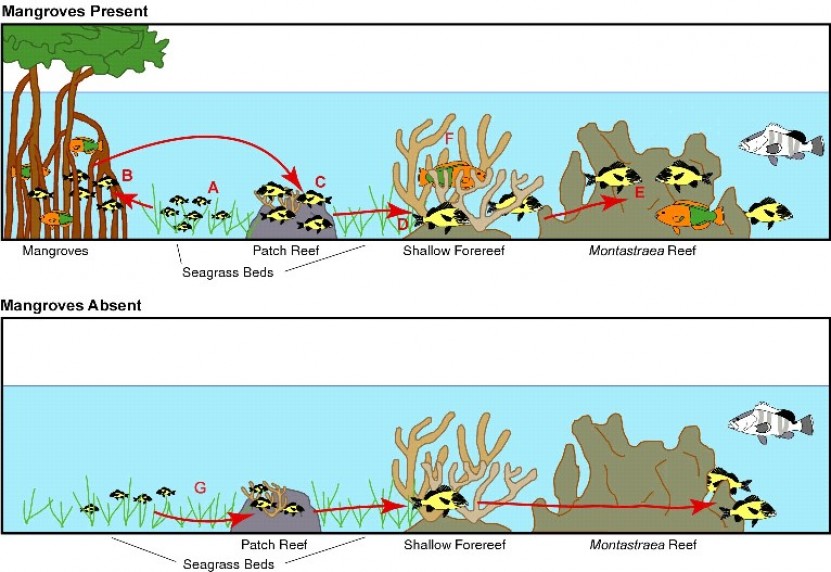Coral reefs and Nurseries

updates
Fish Ecology,
Nurseries.
Mangrove forests are one of the world’s most threatened tropical ecosystems with global loss exceeding 35%.
Juvenile coral reef fish often inhabit mangroves
Mangroves are serving as an intermediate nursery habitat
Increase the survivorship of young fish.
Influence the community structure of fish on neighboring coral reefs.
In addition, the biomass of several commercially important species is more than doubled when adult habitat is connected to mangroves.
Conservation efforts should protect connected corridors of mangroves, seagrass beds and coral reefs.
Predator Prey,
Interactions.
Predation of fishes, particularly new settlers, is an important factor affecting fish populations on reefs.
It is particularly important because mortality is frequently density-dependent; the probability of an individual fish being eaten depends on the abundance of that species.
The probability of mortality may increase or decrease with group size (or be density independent).
The mechanism underlying this density dependence is poorly understood, but in the short term could be driven by the functional response of predators or predator aggregation.
Coral Reefs
¼ of all ocean species depending on reefs for food and shelter.
Reefs cover just a tiny fraction (less than one percent) of the earth’s surface and less than two percent of the ocean bottom.
Coral reefs are often called the rainforests of the sea.
Corals are related to sea anemones
They all share the same simple structure, the polyp.
The polyp is like a tin can open at just one end: the open end has a mouth surrounded by a ring of tentacles.
The tentacles have stinging cells, called nematocysts, that allow the coral polyp to capture small organisms that swim too close.
Inside the body of the polyp are digestive and reproductive tissues.
Corals differ from sea anemones in their production of a mineral skeleton.
Shallow water corals that live in warm water often have another source of food, the zooxanthellae
Pronounced = ZO-O-Zan-THELL-ee !!!
These single-celled algae photosynthesize and pass some of the food they make from the sun’s energy to their hosts, and in exchange the coral animal gives nutrients to the algae.
It is this relationship that allows shallow water corals to grow fast enough to build the enormous structures we call reefs.
The zooxanthellae also provide much of the color that corals have.
Reproduction
Corals have multiple reproductive strategies – they can be male or female or both, and can reproduce either asexually or sexually. Asexual reproduction is important for increasing the size of the colony, and sexual reproduction increases genetic diversity and starts new colonies that can be far from the parents
ASEXUAL REPRODUCTION
Asexual reproduction results in polyps or colonies that are clones of each other - this can occur through either budding or fragmentation.
Budding is when a coral polyp reaches a certain size and divides, producing a genetically identical new polyp. Corals do this throughout their lifetime.
Sometimes a part of a colony breaks off and forms a new colony. This is called fragmentation, which can occur as a result of a disturbance such as a storm or being hit by fishing equipment.
Sexual Reproduction
In sexual reproduction, eggs are fertilized by sperm, usually from another colony, and develop into a free-swimming larva.
There are two types of sexual reproduction in corals, External and Internal.
Depending on the species and type of fertilization, the larvae settle on a suitable substrate and become polyps after a few days or weeks, although some can settle within a few hours!
They exist because the growth of corals matches or exceeds the death of corals – think of it as a race between the construction cranes (new coral skeleton) and the wrecking balls (the organisms that kill coral and chew their skeletons into sand).
When corals are babies floating in the plankton, they can be eaten by many animals. They are less tasty once they settle down and secrete a skeleton, but some fish, worms, snails and sea stars prey on adult corals.
Crown-of-thorns sea stars are particularly voracious predators in many parts of the Indian Ocean.
Population explosions of these predators can result in a reef being covered with tens of thousands of these starfish, with most of the coral killed in less than a year.



